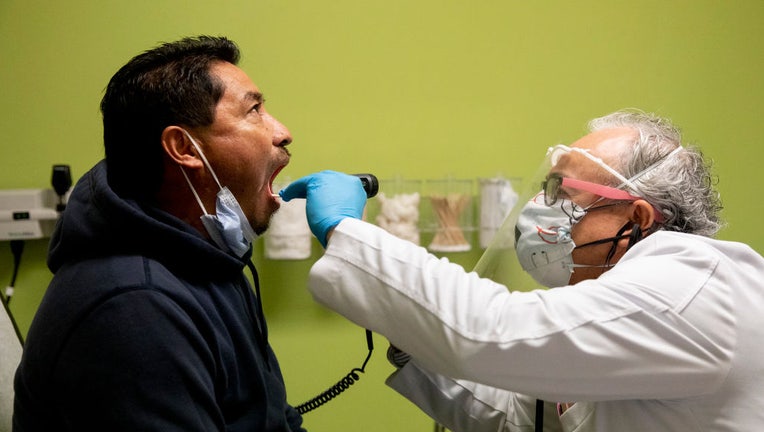Strep throat infections have spiked above pre-COVID highs, says report: 'We've missed cases'

FILE-A doctor checks a man for a sore throat. (Jessica Christian/The San Francisco Chronicle via Getty Images)
After plummeting during the COVID pandemic in 2020 and 2021, strep throat infections skyrocketed in February 2023, according to a report from Epic Research, a health analytics firm.
The rate of infections of group A strep (caused by the Streptococcus bacteria) was 30% higher than the previous peak seen in February 2017, the report found.
Leading up to the pandemic, between January 2017 and February 2020, cases of strep throat followed a consistent pattern. Usually, the cases would begin to increase in the fall and peak in February — before dipping again in spring and summer, said the reports from Epic, which is based in Verona, Wisconsin.
'GREAT CONCERN': INVASIVE GROUP A STREP CASES SPIKING IN PARTS OF US — CDC IS INVESTIGATING
Starting in March 2020, amid stay-at-home orders early in the pandemic, strep throat infections plummeted.
Preliminary data from the Centers for Disease Control and Prevention (CDC) showed that severe cases of strep infections decreased by around 25% during the pandemic.
Strep cases didn’t start to increase again until September 2022, then skyrocketed in the winter leading into 2023.

FILE-A woman visits a pharmacy for a consultation for a sore throat. (Photo By BSIP/UIG Via Getty Images)
Epic’s data is based on the share of clinic and emergency room visits between January 2017 and February 2023 that resulted in positive group A strep cases across the U.S. and Lebanon. (The data come from "Cosmos, a HIPAA-defined Limited Data Set of more than 184 million patients from 199 Epic organizations including 1,147 hospitals and more than 24,900 clinics," said Epic in its report, in part.)
A majority of the cases affected children ages 4 to 13.
HOSPITALS AND HEALTH CARE FACILITIES SHOULD DROP MASK REQUIREMENTS, MEDICAL EXPERTS SAY
"The rates of group A strep infections, including the more dangerous invasive type, are at the highest levels seen in years," confirmed Dr. Shana Johnson, a physical medicine and rehabilitation physician in Scottsdale, Arizona.
The CDC’s early data also reflect these findings, showing that cases of both invasive and less severe strep are at elevated levels, "similar to or higher than those seen in pre-pandemic years."
Other viruses could have fueled strep cases
Dr. Marc Siegel, a professor of medicine at NYU Langone Medical Center and a Fox News medical contributor, told Fox News Digital that the spike in strep A cases is likely a result of other circulating viruses.
"The recent assault of viruses, including COVID-19, have weakened people’s immune systems," he told Fox News Digital.
"Also, we haven't been on the lookout for it and have missed cases."
When strep leads to invasive infections
In most cases, strep A causes mild illness, with common symptoms including sore throat, pain when swallowing, fever, red and swollen tonsils, swollen lymph nodes and tiny red spots on the roof of the mouth, per the CDC.
Occasionally, group A strep can lead to severe infections (invasive Group A strep, or iGA), which in rare cases can cause sepsis, streptococcal toxic shock syndrome and necrotizing fasciitis (a serious bacterial infection that destroys tissue). These cases require immediate treatment.
In the U.S., there are between 14,000 and 25,000 cases of invasive group A strep cases per year, with 1,500 to 2,300 of them causing death, the CDC reported.
"Unlike respiratory viral illnesses like the common cold and flu, group A strep is best treated with antibiotics," Dr. Johnson told Fox News Digital.
"Antibiotics for strep throat reduce how long you are sick and prevent the infection from getting more severe and spreading to other parts of the body."
Understand the shortage of antibiotics
With the current antibiotic shortage, some cases aren’t receiving timely treatment, Dr. Siegel said.
"When we don't treat it quickly, it has more time to spread," he told Fox News Digital.
EUROPEAN UNION DRUG REGULATOR DETERMINES ANTIBIOTIC SHORTAGE NOT A ‘MAJOR EVENT’
In October 2022, the U.S. Food & Drug Administration (FDA) reported a shortage of amoxicillin, which, along with penicillin, is among the most commonly prescribed treatments for strep.
As of April 2023, amoxicillin remains on the drug shortage list.
Tips for preventing strep’s spread
Group A strep bacteria spreads through droplets when an infected person coughs, sneezes or talks, per the CDC’s website.
"If you touch your mouth, nose, or eyes after touching something that has these droplets on it, you may become ill," the CDC said.
To help reduce the spread, doctors say to wash hands often with soap and water, avoid sharing glasses or utensils with those who are infected, and cover the mouth and nose when coughing or sneezing.
"If you have strep throat, stay home until you no longer have a fever and have taken antibiotics for at least 24 hours," Dr. Johnson advised.
Early testing and treatment is important, especially among young children, Dr. Siegel said.
"If you have strep throat, stay home until you no longer have a fever and have taken antibiotics for at least 24 hours," Dr. Johnson advised.
"Consider using other antibiotics if amoxicillin is in short supply," he added.

